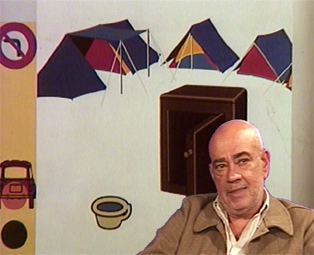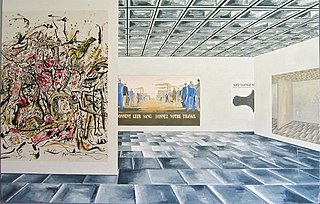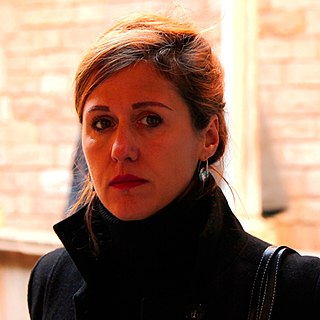
The Centre Pompidou, more fully the Centre national d'art et de culture Georges-Pompidou, also known as the Pompidou Centre in English, is a complex building in the Beaubourg area of the 4th arrondissement of Paris, near Les Halles, rue Montorgueil, and the Marais. It was designed in the style of high-tech architecture by the architectural team of Richard Rogers, Su Rogers, Renzo Piano, along with Gianfranco Franchini.

Valéry Grancher is a French Internet-based artist, performer, theorist, curator and lecturer.

ORLAN is a French multi-media artist who uses sculpture, photography, performance, video, video games, augmented reality, artificial intelligence, and robotics as well as scientific and medical techniques such as surgery and biotechnology to question modern social phenomena. She has said that her art is not body art, but 'carnal art,' which lacks the suffering aspect of body art.

Jean-Marc Bustamante is a French artist, painter, sculptor and photographer. He is a noted conceptual and installation artist and has incorporated ornamental design and architectural space in his works.

Pierre Bismuth is a French artist and filmmaker based in Brussels. His practice can be placed in the tradition of conceptual art and appropriation art. His work uses a variety of media and materials, including painting, sculpture, collage, video, architecture, performance, music, and film. He is best known for being among the authors of the story for Eternal Sunshine of the Spotless Mind (2004), for which he won the Academy Award for Best Original Screenplay alongside Michel Gondry and Charlie Kaufman. Bismuth made his directorial debut with the 2016 feature film Where is Rocky II?.
M/M (Paris) is an art and design partnership consisting of Mathias Augustyniak and Michael Amzalag, established in Paris in 1992.

Fabienne Verdier is a French painter who works in France after years of studies in China. She was the first non-Chinese woman to be awarded a post-graduate diploma in fine arts by the Sichuan Fine Arts Institute in Chongqing, China.
Jan Kopp is a German visual artist. He has lived in France since 1991.

Tsuneko Taniuchi, born in Nishinomiya, Hyōgo, Japan, in 1946, is a contemporary artist, who uses performance as her main medium. Her practice, which oscillates between scripted situations and participatory works, aims to question cultural, social, and sexual constructions, linked to notions of identity, immigrations, and feminism.

Nancy Wilson-Pajic is an artist who uses narrative forms to make narrative, content-oriented artworks.

Meir Eshel, known professionally as Absalon, was an Israeli-French artist and sculptor.

Carmen Lydia Đurić, known by her artist name Hessie, was a Cuban textile artist who lived in France from 1962 until her death. Her creative work was mainly focused on embroidery using fabrics, although she also used the technique of collage with waste materials.

Vera Pagava was a Georgian artist based in Paris.

Hervé Télémaque was a French painter of Haitian origin, associated with the surrealism and the narrative figuration movements. He lived and worked in Paris from 1961 on.

Index: Incident in a Museum is an extensive series of paintings produced between 1985 and 1988 by Michel Baldwin and Mel Ramsden, members of the British conceptual artists' collective Art & Language.

Nina Kovacheva, is a French-Bulgarian artist. She lives and works in France.
Valentin Stefanoff is a French-Bulgarian artist. He lives and works in France.
Martine Aballéa is a French-American artist born in 1950.

Vincent Bioulès is a French painter, born on March 5, 1938 in Montpellier, where he lives and works.

Jean Le Gac is a French conceptual artist, painter, pastelist, photographer using mixed media, frequently video or photography and text to document his investigations and sketched scenes. His poetic photographic interventions in which he is most often the main subject are accompanied either by typed text describing the underlying story in the artwork or handwritten notes in the art piece itself. Member of the Narrative art movement since the seventies, Le Gac ofttimes tells a story about an imaginary character that viewers can easily identify with the artist himself. He calls it a “metaphor for painting." Le Gac also uses the artist's book as a central part of his art practice. Le Gac is a Professor and lecturer at Institut des hautes études en arts plastiques.
















